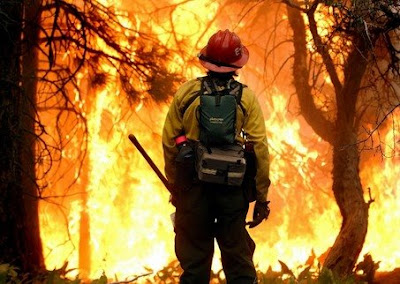From the Oregonian
By Andy Stahl
There's nothing like a good forest fire year to stimulate the economy. Last year the federal government spent $1.4 billion to fight forest fires. Daily spending on a single wildfire can top $1 million as the Forest Service pumps out contracts to rent porta-potties, retardant bombers and bulldozers.
Firefighting is shovel-ready spending. Within minutes of a fire's ignition, the Forest Service has on-the-ground incident command teams with contracting officers authorized to cut hundred-thousand dollar checks on the spot.
Firefighting does have some unintended consequences - unhealthy forests, massive insect epidemics, old-growth trees crowded out by invasive newcomers. But like the federal debt, we let the next generation pay these costs while we reap the short-term benefits.
OK, I'm only kidding. I don't really want big forest fires this year. Firefighting is a cost, not a benefit. Like all costs, it should be incurred only when its benefits are greater. And that's the question I have for the economic stimulus spending our government has embarked upon this year. Is each of its costs, which our children will end up paying, outweighed by its benefits?
The Forest Service is slated to receive from Congress $300 million to pay for hazardous fuels reduction projects on federal land. Hazardous fuels reduction includes removing small trees from forests, mowing brush and prescribed burning.
The National Fire Plan created the hazardous fuels reduction program. The Forest Service says the fuels program is intended "to help save the lives of firefighters and citizens and to reduce the risk of catastrophic fire to our communities, forests, and rangelands." Since its adoption in 2001, the NFP's hazardous fuels program has treated fuels on 29 million acres at a cost of $2 billion.
So what's been the return on our $2 billion investment? Has the program saved lives, reduced fires or protected communities? From 2001 through 2007, 136 firefighters have lost their lives in the line of duty. In the preceding seven-year period (1994-2000), 130 firefighters died. Under the NFP, fires have burned an average of 7 million acres each year. In the seven-year period before the NFP, fires burned 4 million acres a year. In the last seven years, firefighting costs averaged $1.4 billion a year. In the preceding period before the NFP, costs averaged half that amount. Under the NFP, 1,482 houses have been lost annually to wildfires (most are in Southern California), compared to an average 563 houses lost yearly in the two years (for which I have data) before the NFP.
Economist John Maynard Keynes advised that government should spend its stimulus money on something "sensible," but even if it chose to "fill old bottles with banknotes, bury them at suitable depths in disused coal mines, which are then filled up to the surface with town rubbish, and leave it to private enterprise on well-tried principles of laissez-faire to dig the notes up again," that would be better than nothing.
Congress and the Forest Service appear to have taken Keynes at his word.
Andy Stahl is executive director of Forest Service Employees for Environmental Ethics in Eugene.
Thanks Dick
How To Use Storytelling To Sell Dream Vacations
-
People do not buy trips based on hotel names or flight schedules. They buy
the feeling of escape, connection, and anticipation. Storytelling is one of
th...
2 days ago





No comments:
Post a Comment